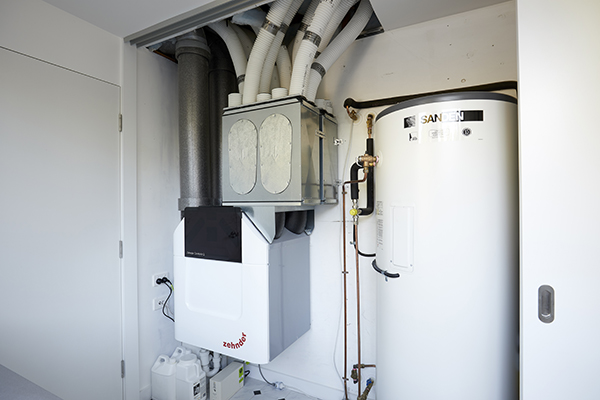HRV vs Other Ventilation Systems: How They Compare
Just How Heat Recovery Ventilation Boosts Indoor Air Quality and Reduces Energy Costs
Heat Recovery Ventilation (HRV) systems play a crucial role in enhancing indoor air quality while at the same time lowering power costs. By successfully trading stagnant indoor air with fresh exterior air, HRVs assist keep optimal moisture and decrease pollutants. Additionally, their capability to recoup heat from outgoing air reduces the stress on heating and cooling down systems. As energy prices remain to increase, comprehending the complete potential of HRV systems ends up being increasingly essential for home owners and businesses alike.
Understanding Heat Recovery Ventilation Solutions

Heat recovery ventilation (HRV) systems play a vital function in improving indoor air top quality, particularly in contemporary, energy-efficient buildings. These systems are designed to move heat from the outgoing stale air to the incoming fresh air, therefore decreasing power loss while maintaining optimal temperature level levels inside your home. HRVs contain a warmth exchanger, followers, and ductwork, assisting in the continuous circulation of air. By eliminating interior toxins and introducing fresh air, HRVs aid to stabilize humidity degrees, prevent mold development, and reduce irritants. The effectiveness of HRV systems hinges on their capacity to recuperate approximately 80% of the warm from the worn down air, promoting power conservation while guaranteeing a healthy and balanced indoor atmosphere. Their assimilation is essential in attaining sustainable living techniques.
The Importance of Indoor Air Quality
Indoor air quality (IAQ) is a vital factor influencing the health and wellness of owners in any setting. Poor IAQ can lead to various health and wellness problems, including respiratory system troubles, allergies, and tiredness. Furthermore, it can aggravate status quo such as bronchial asthma. Aspects adding to reduced IAQ include contaminants from interior sources like cleaning agents, mold and mildew, and insufficient ventilation. Preserving excellent IAQ is essential for promoting a risk-free and comfortable living or functioning area. Efficient methods to boost IAQ entail regular monitoring of air top quality, appropriate air flow systems, and minimizing making use of damaging materials inside your home. By prioritizing IAQ, people can ensure a healthier atmosphere that promotes efficiency and total lifestyle.
Power Effectiveness Advantages of HRV Equipments
Many home owners and structure managers are progressively identifying the energy effectiveness advantages of warm recuperation air flow (HRV) systems. By moving heat from tired interior air to inbound fresh air, HRV systems substantially minimize the power needed for heating and air conditioning. This process lessens reliance on traditional a/c systems, leading to lower energy costs. Additionally, HRVs help preserve a balanced interior climate, stopping too much heating or cooling down needs. The capability to recoup approximately 90% of the heat from outbound air also sustains sustainability efforts by lowering overall power intake. HRV systems contribute not only to cost savings but additionally to a reduced carbon footprint, aligning with the growing focus on energy-efficient building methods.
Setup and Upkeep Considerations
The efficient implementation of heat recovery ventilation (HRV) systems requires careful consideration of installation and upkeep aspects to ensure peak performance. Proper positioning of the HRV unit is necessary, as it must be mounted in a place that takes full advantage of air movement while minimizing sound disruption. Furthermore, ductwork must be suitably sized and shielded to stop power loss. Regular upkeep, consisting of filter substitute and system cleaning, is crucial to protect optimum functionality and interior air quality. Owners should establish a routine upkeep schedule to recognize and attend to potential problems prior to they rise. Collaboration with skilled specialists during both setup and upkeep phases can improve the longevity and performance of HRV systems, ultimately causing far better interior environments and reduced power prices.
Real-World Applications and Success Stories
Exploring real-world applications of warm healing air flow (HRV) systems discloses their substantial effect on indoor air quality and energy performance throughout numerous setups. In domestic buildings, home owners have reported better air quality, resulting in fewer allergic reactions and read the full info here respiratory problems. Schools executing HRV systems have noted improved trainee concentration and lowered absenteeism as a result of much better air flow. Commercial buildings, such as workplaces and retail areas, have actually experienced lower energy costs and boosted worker productivity. A business workplace in a pleasant environment attained a 30% decrease in energy costs after setting up an HRV system. These success stories demonstrate that HRV technology not only adds to healthier environments but additionally supplies substantial monetary benefits, making it a valuable financial investment for various industries.
Regularly Asked Inquiries
Can HRV Systems Decrease Irritants in Indoor Air?
The efficiency of HRV systems in reducing interior irritants mainly hinges on their ability to filter and exchange air. HRV Heat Recovery Ventilation. By continuously changing stale air, these systems can substantially decrease irritant degrees throughout interior environments

Just How Does Humidity Affect HRV System Efficiency?
Humidity considerably influences HRV system performance; high levels can bring about condensation, lowering performance, while why not find out more reduced humidity may improve air exchange. Stabilizing moisture is essential for ideal procedure and preserving interior air high quality.
Are HRV Equipments Noisy Throughout Procedure?
HRV systems can produce differing noise levels throughout procedure, depending upon their style and setup. Some units run silently, while others might produce recognizable sound, particularly at higher air movement settings or when improperly kept.
What Is the Ordinary Lifespan of an HRV System?

Can HRV Systems Be Made Use Of in All Environments?
HRV systems can be used in various climates, but their performance may differ - HRV Heat Recovery Ventilation. In severe temperature levels, changes or supplementary systems could be necessary Homepage to guarantee optimal performance and convenience while preserving indoor air quality